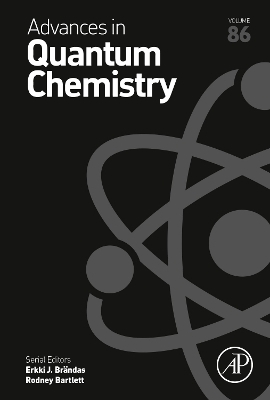
Advances in Quantum Chemistry
Academic Press Inc (Verlag)
978-0-443-18665-3 (ISBN)
Additional sections cover Molecular systems in spatial confinement: variation of linear and nonlinear electrical response of molecules in the bond dissociation processes, Relativistic Infinite-order two-component methods for heavy elements, Second quantized approach to exchange energy revised – beyond the S^2 approximation, Calculating atomic states without the Born-Oppenheimer approximation, Convergence of the Correlated Optimized Effective Potential Method, and more.
Erkki Brändas was born in Tampere, Finland in July1940 and was, as a Finnish war child, transported to Sweden in February 1942, finally adopted by his Swedish parents and given Swedish citizenship in 1947. He received his FL (PhD) in 1969 and Doctor of Philosophy (habilitation) in 1972, both at Uppsala University. Except for guest professorships in USA, Germany, Israel, he spent his professional career in Uppsala employed as Assistant- Associate- and Full Professor from 1975 until retirement in 2007. In addition to serving as chairman of the department of Quantum Chemistry, he was appointed Executive Director of the Uppsala Graduate School Advanced Instrumentation and Measurement supervising the doctoral education of 35 PhD’s from 1997-2007. He has served on various international scientific and editorial boards, e.g. Wiley, Elsevier and Springer including the service as Editor-in-Chief for the International Journal of Quantum Chemistry, Series Editor of the Advances in Quantum Chemistry. He is the current President of the International Society for Theoretical Chemical Physics, since 15 years, chairing a variety of international congresses and other numerous meetings, schools and workshops. He has published over 260 articles and edited more than 50 books on fundamental theoretical chemical physics from research on atoms, molecules and solid-state physics to complex enough systems in biology – from the microscopic realm to the cosmological rank. Rod Bartlett pioneered the development of coupled-cluster (CC) theory in quantum chemistry to offer highly accurate solutions of the Schroedinger equation for molecular structure and spectra, presenting the CCSD, CCSD[T], CCSDT, CCSDT[Qf], and CCSDTQ methods among many others. He extended the CC theory to excited, ionized, and electron attached states with his equation-of-motion EOM-CC methods. His group formulated analytical gradient theory for CC theory, making it possible to readily search potential energy surfaces and to provide vibrational spectra. His group introduced the STEOM-CC extensions for excited states. His group is also responsible for the widely used ACES II and massively parallel ACES III program system. He is the author of more than 500 journal articles and book chapters. He is the co-author with Isaiah Shavitt of the definitive book on coupled-cluster theory, “Many-Body Methods in Chemistry and Physics: MBPT and Coupled-Cluster theory, Cambridge Press, 2009.
1. Can orbital basis sets compete with explicitly correlated ones for few-electron systems? Krzysztof Szalewicz 2. Converging high-level equation-of-motion coupled-cluster energetics with the help of Monte Carlo and selected configuration interaction Piotr Piecuch 3. Coupled cluster downfolding techniques: a review of existing applications in classical and quantum computing for chemical systems Karol Kowalski 4. Multi-reference methods for the description of dynamic and nondynamic electron correlation effects in atoms and molecules Leszek Meissner 5. Exploring the attosecond laser-driven electron dynamics in the hydrogen molecule with different TD-CI approaches Aleksander Wozniak 6. Molecular systems in spatial confinement: variation of linear and nonlinear electrical response of molecules in the bond dissociation processes Wojciech Bartkowiak 7. Relativistic Infinite-order two-component methods for heavy elements Maria Barysz 8. Second quantized approach to exchange energy revised – beyond the S^2 approximation Piotr Zuchowski 9. Calculating atomic states without the Born-Oppenheimer approximation Monika Stanke 10. Convergence of the Correlated Optimized Effective Potential Method Szymon Filip Smiga 11. Generalized Relaxed Excitation with a Non-integer Particle and Hole Charge as an Excitation Order Katarzyna Pernal 12. Vanadium – based Materials for Catalytic Applications: Insight from Density Functional Theory Malgorzta Witko 13. Electronic convection in coherent information-theoretic description of molecular states Roman F. Nalewajski 14. Interparticle correlations and chemical bonding from physical side: Exact diagonalization combined with ab initio wave function adjustment Jozef Spalek and Ewa Broclawik 15. ETS-NOCV and Molecular Electrostatic Potential-based Picture of Chemical Bonding Artur Michalak 16. Electrostatic Embedding for Elongation Cutoff Technique – Method Accuracy Jacek Korchowiec 17. From the Kolos-Wolniewicz calculations to the quantum-electrodynamic treatment of the hydrogen molecule: competition between theory and experiment Jacek Komasa 18. Making symmetry-adapted perturbation theory more accurate Konrad Patkowski and Tatiana Korona 19. Advanced models of coupled cluster theory for the ground, excited and ionized states Monika Musial and Stanislaw Kucharski
| Erscheinungsdatum | 17.10.2022 |
|---|---|
| Reihe/Serie | Advances in Quantum Chemistry |
| Verlagsort | San Diego |
| Sprache | englisch |
| Maße | 152 x 229 mm |
| Gewicht | 660 g |
| Themenwelt | Naturwissenschaften ► Chemie ► Physikalische Chemie |
| Naturwissenschaften ► Physik / Astronomie ► Angewandte Physik | |
| Naturwissenschaften ► Physik / Astronomie ► Atom- / Kern- / Molekularphysik | |
| ISBN-10 | 0-443-18665-0 / 0443186650 |
| ISBN-13 | 978-0-443-18665-3 / 9780443186653 |
| Zustand | Neuware |
| Haben Sie eine Frage zum Produkt? |
aus dem Bereich


